Intro written by Braden Keith.
Another US selection meet has come and gone, and it feels unlike any we’ve seen in at least a generation. After the weirdness of Tokyo, there was a massive changing of the guard this week, with first-timers, and veterans like Caeleb Dressel, Michael Andrew, Hali Flickinger, and others missing the team.
When I look up-and-down this year’s roster, I feel conflicted about how their prospects.
On the one hand, I don’t really feel great about how they’re going to do at this year’s World Championships. There are still a few superstars to carry the Americans through (Katie Ledecky, Lilly King, Regan Smith, Bobby Finke), but it feels like a team that is going to struggle to pile up medals at this year’s World Championships. It’s within the realm of reason that the US could get beat out to top the medals table this year for the first time in a while.
But what I feel great about is where this sets the US up for next year. This was almost a Darwinian Trials. The young talented kids (and it’s felt like a golden generation that’s entering the latter half of their high school careers right now) is seeing the pathways to the big teams. Not just the World Juniors or Pan Am Games teams, but the BIG teams – the Worlds and the Olympics.
And while a lot of veterans struggled at this meet, it seems like a lot of them might need that summer off. That summer to evaluate, regroup, and push forward to Paris. It’s sort of the lactate paradox – some will see it as fuel to renew their spirit for one last push, while others will crack under the pain.
When the former group runs headlong into the young, motivated generation, the outcome is going to be explosive. The 2024 US Olympic Trials could be one for the history books. I can’t wait.
Hits And Misses
Written by Yanyan Li.
Hit: Short Course Yards
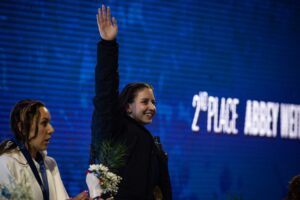
Kate Douglass (photo: Jack Spitser)
A common theme from this year’s Nationals can be described with one phrase: “short course specialists no more”.
At Nationals, we saw a myriad of America’s best short-course swimmers prove that they can do as well in long course. And of course, the biggest example is Kate Douglass. After graduating from Virginia as arguably the best female college swimmer since Natalie Coughlin, she showed that she could be a potential gold medal contender in the big pool as well, clocking a 2:07.09 200 IM to break the U.S. Open record and go into World Championships as the second overall seed. She also became the second-fastest American woman ever in the 100 free with her 52.57 and qualified for Worlds in the 200 breast. As America’s top female sprinter, Douglass will likely have to take on the biggest role that any American woman will have in Fukuoka, and she’ll become one of the World’s best long-course swimmers if she manages to pull it off.
But the success of so-called “yards swimmers” isn’t just exclusive to Douglass, but it was present amongst many of her teammates. Three-time individual national champion Gretchen Walsh (who is KNOWN for her incredible underwaters) broke through at Nationals, qualifying for her first senior international team in four different events (three individually) and breaking the American record in the 50 fly (25.11). Maxine Parker had a great meet as well, dropping 0.7 seconds in her 100 free to make Worlds in the 4×100 free relay. And after winning two NCAA titles in the 400 IM, Alex Walsh found her groove in the long course version of the event, shaving nearly seven seconds off her best time to place second overall at Nationals. With four female swimmers set to swim in Fukuoka, Virginia has placed more women on Worlds team than any other training group. After winning three consecutive NCAA team titles, Todd DeSorbo and the Cavaliers have showed that the best short course team can also be the best in long course.
The yards-start-to-meters-star pipeline does not end with Virginia. Bella Sims, a highly versatile yards swimmer who is arguably one of the best recruits in NCAA history, qualified to swim individual events at Worlds for the first time. Destin Lasco, the most dominant men’s 200 backstroker in the NCAA right now, dropped over a second to swim the event at Worlds and also nabbed a spot on the 4×100 free relay. In fact top four finishers in the men’s 100 free are all current NCAA swimmers.
The fact that so many yards stars converted their success over to meters at Nationals goes to show that just because a swimmer is only good at short course doesn’t mean they’ll never develop in long course. I think the extended period between NCAAs in March and Nationals in June gave a lot of college swimmers ample time to explore their true potential in long course, which is something that they didn’t get last year when only a month separated NCAAs and trials. The main verdict? Don’t be quick to label someone as a “bathtub specialist”.
Miss: Male Multi-Event Threats

Michael Andrew (photo: Jack Spitser)
For as long as we could remember, both the USA Swimming selection procedure and the roster limit were a non-issue for the American men. Stars like Michael Phelps, Ryan Lochte, and Caeleb Dressel all consistently qualified for multiple individual events, so there wasn’t much concern over whether there would be enough “doubles” to fit all of the projected qualifiers on a Worlds/Olympics squad.
However, after many of America’s male multi-event threats underperformed at Nationals this year, roster limit became a concern.
In hindsight, Dressel not making the Worlds team wasn’t super surprising. He had been out of the water for eight straight months and only started training the way he used to train this May. The fact that he made the podium in a race is impressive already. But what did come as a surprise was the struggles of Michael Andrew. After qualifying for Worlds in five different individual events last year, he missed the Worlds team this year because he was the designated “first man out” per the USA Swimming Selection procedure. And though he won’t be going to Fukuoka because of selection procedure, he wouldn’t have been in this situation if he was in 2022 form—to go from being a projected qualifier in five events to only winning one event is a drastic turn.
It’s not just Dressel and Andrew. Shaine Casas was a contender to make Worlds in the 100 free, 200 back, 50 back, 100 back, 100 fly and 200 IM, but he only qualified in the 200 IM after a rollercoaster of events. For the first time since 2017, Team USA didn’t have the same two qualifiers in the men’s 800 and 1500 free–Charlie Clark qualified alongside Bobby Finke in the 1500 free, but Ross Dant did so in the 800. Carson Foster was the only male swimmer to qualify for more than two individual events.
If there’s one thing we’ve learned from what went down at Nationals, it’s that the American men have to move on from their Phelps, Lochte and Dressel era. They no longer have one or two superstars that can win multiple gold medals and be the face of swimming—which, on the men’s side, is becoming increasingly dominated by Europeans. But on the bright side, this year will give the American men a chance to reset, regroup, and give these young and rising swimmers (Thomas Heilman, am I right?!?!?!) an opportunity to create their own narrative.
Hit: The American Women
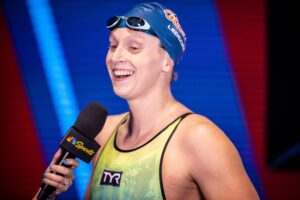
Katie Ledecky (photo: Jack Spitser)
Even though the American men are struggling, the American women quite literally look like The Avengers on water. At Nationals, they put their depth on display, setting four U.S. Open records and an American record in the process. In fact, I think they proved that they could feasibly medal in every event at Worlds with the exception of *maybe* the 200 free, and will be the favorites once more to top the medal table in Fukuoka.
Let’s start from the bottom up. Abbey Weitzeil is the third-fastest swimmer in Fukuoka’s 50 freestyle field. In the 100 free, which was once their biggest weakness, the American women have three different 52-point swimmers. Even though they don’t have any individual medal contenders in the 200 free, they are the defending World Champions in the 4×200 free relay and have only gotten better. Katie Ledecky is the runaway favorite in the 800 and 1500 free, and a medal lock in the 400 free. Torri Huske is the defending World Champ in the 100 fly, while Regan Smith is the top seed in the 200 fly by nearly a second. Oh, and speaking of Smith, she and Kaylee McKeown are well ahead of the rest of the world in the backstroke, while Katharine Berkoff is the top seed in the 50 back and the fifth-fastest 100 backstroke of all-time. Lilly King and Lydia Jacoby are the only two 100 breaststrokers who have been under 1:05, while King is the defending World Champ in the 200 breast. The crazy-versatile Kate Douglass is a medal threat in the 100 free, 200 breast, and 200 IM, Alex Walsh can possibility podium in both IM, and Katie Grimes is the defending silver medalist in both the 400 IM and the 1500 free. The American women have a chance at sweeping all three relays (the Australians still have an advantage in the 4×100 free relay, but the Americas have a greater shot at winning than they did in past years), and are runaway favorites in the medley relay.
And speaking of that medley relay, the options that the American women have are incredible. As Twitter user @cholrinebabey pointed out, a 4×100 medley made up of the third-place finishers in the 100-stroke events at Nationals would have won at the 2022 World Championships (where the actual winners were also the Americans), and the first-place finishers would have been fast enough to break Australia’s 2021 Olympic record and less than a second off of the World Record time of 3:50.40. And none of this even accounts for relay exchanges.
USA Women’s A/B/C medley relay:
57.71-1:04.75-56.18-52.57 = 3:51.21
58.01-1:05.16-56.34-52.92 = 3:52.43
58.59-1:05.48-56.43-53.14 = 3:53.64So the A team would set an Olympic record w/o relay starts and their C team—of people who didn’t qualify—would have won 2022 Worlds 😳 https://t.co/zmqBf6E92o
— seapipers of hawai’i (@chlorinebabey) July 1, 2023
| Top Finishers, U.S. Nationals | Second-Place Finishers, U.S. Nationals | Third-Place Finishers, U.S. Nationals | U.S. Women’s Medley Relay, 2022 World Championships | World Record (United States, 2019) | |
| Back | 57.71 – Regan Smith | 58.01 – Katharine Berkoff | 58.59 – Claire Curzan | 58.40 – Regan Smith | 57.57 – Regan Smith |
| Breast | 1:04.75 – Lilly King | 1:05.16 – Lydia Jacoby | 1:05.48 – Kaitlyn Dobler | 1:05.89 – Lilly King | 1:04.81 – Lilly King |
| Fly | 56.18 – Torri Huske | 56.34 – Gretchen Walsh | 56.43 – Kate Douglass | 56.67 – Torri Huske | 56.16 – Kelsi Dahlia |
| Free | 52.57 – Kate Douglass | 52.92 – Abbey Weitzeil | 53.14 – Gretchen Walsh | 52.82 – Claire Curzan | 51.86 – Simone Manuel |
| Total | 3:51.21 | 3:52.43 | 3:53.64 | 3:53.64 | 3:50.40 |
And while Summer McIntosh and the country of Australia will be challengers, the American women look to be in very good shape heading into Fukuoka this summer.
Miss: The Officiating
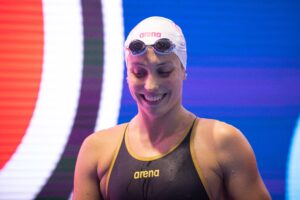
Emma Weyant (photo: Jack Spitser)
Officiating creates controversy at every swim meet, especially when DQs happen. But at Nationals, it was a chronic problem.
During prelims on day three of Nationals, there was a grand total of seven DQs called, with six of them coming from the men’s and women’s 400 IM. The two DQs that garnered the most attention were those of Emma Weyant and Max McHugh, who were both called for doing butterfly kick during breaststroke. Weyant, the defending Olympic silver medalist and Worlds bronze medalist in the 400 IM, had originally qualified for finals as the second seed. According to her coach, Anthony Nesty, she had said that her swim was arguably her best prelims swim ever. Now, she’ll have to watch Team USA compete in Fukuoka from home, being denied of a chance to qualify for Worlds in her best event. McHugh, meanwhile, had a breakthrough swim in the 50 breast. He swam a 26.84 in prelims, which was a personal best by 0.34 seconds, and was just 0.1 of a second off of Nic Fink’s finals win time. That being said, he probably would not have made Worlds even if he did end up winning the 50 breast final, given how the USA Swimming selection procedure works.
The first reason why people were upset over rampant DQs was because there was a lack of transparency surrounding them. The general public is not provided with further information about the DQs beyond what the announcer gives them, and the USA Swimming livestream does not display a clear angle that allows for people to see how the swimmers are kicking (or any other reason for the DQ). Worlds team member Kieran Smith even criticized the officiating at Nationals, saying that the DQs were “ridiculous” and inconsistent. Heck, it even got to the point where there was audible booing in the stands when a DQ call was made, and cheering when a heat was gotten through without a DQ.
In addition, officiating also caused a lot of delays in the meet. Even when DQs weren’t called, several heats were put under video review, which delayed the start times of the heats that came afterward. Even though Day 3 prelims were scheduled to end at 12:31 PM EST, it didn’t actually end until around 1 PM. Eventually, officials just allowed for later heats to run simultaneously with video review, which ended up saving much more time.
Of course, the DQ madness could just be seen as the calm before the storm (both figuratively and literally) on day three. Just a few hours later, a massive storm caused power outages throughout Indianapolis (including at the JW Marriott, the hotel where many swimmers were staying at), which delayed the start time of the finals session by 30 minutes.
Hit: The Veterans
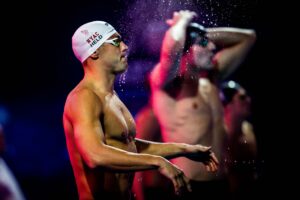
Ryan Held (photo: Jack Spitser)
Although the Worlds team is dominated by new faces, there were several veterans that bounced back to book their ticket to Fukuoka as well.
A prime example is Abbey Weitzeil. After failing to qualify for Worlds last year, she had a breakthrough meet at Nationals this year, setting personal bests in the 50 and 100 free and qualifying to swim both events individually in Fukuoka. Olivia Smoliga also saw a resurgence in her career, placing fourth in the 100 free and third in the 50 free (and going best times in both events). After it looked like she was never going to qualify for a senior international team again after missing Worlds last year, she now could potentially having a finals relay spot in Fukuoka. Leah Smith didn’t let herself get drowned out by the teenagers in the distance free races, placing fifth in the 200 free and third in the 400 free with a remarkable time of 4:03.85. Lilly King proved that she wasn’t “past her prime”, breaking 1:05 for the first time since 2021 in the 100 breast and swimming her second-fast time ever in the 200 breast. Katie Ledecky swam her fastest 800 free time since 2016.
On the men’s side, there were also plenty of veterans that showed out. 28-year-old Ryan Held won the 50 free, qualifying to swim an individual event at a senior international meet for the first time. Then 29-year-old Nic Fink went a best time in the 100 breast on top of working a 9-5 job. Ryan Murphy continues to dominate in the 200 back, while Chase Kalisz qualified for his sixth-straight World Championship meet. And while Cody Miller didn’t make Worlds, he still had a strong swim in the 100 breast, breaking a minute for the first time since 2020 and likely qualifying for the Pan American Games.
As said in my article highlighting the top SwimSwam comments from Nationals, it’s never too late to bounce back after a bad meet, even if age isn’t on your side.
Miss: The Veterans
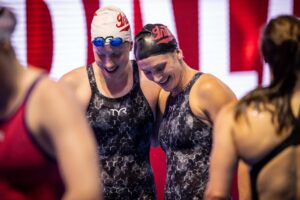
Lilly King and Annie Lazor (photo: Jack Spitser)
Even though many veterans shined at Nationals, other people that were expected to qualify comfortably missed their mark.
Of course, we’ve talked about Dressel and Andrew. But it goes beyond them. Claire Curzan swam five different individual events at Worlds last year and managed to qualify for none this year, though she was hospitalized a week prior to Nationals and nearly scratched out of the meet. Erika Brown, Natalie Hinds, and Brooks Curry were all on 4×100 freestyle relays for the last two years, but neither of them made the 100 free ‘A’ final this year. Tokyo Olympic and Budapest Worlds medalist Hali Flickinger finished seventh in the 200 fly and scratched the rest of the meet, even though a time she swam three weeks ago would have finished second. Despite breaking 54 seconds and setting a personal best, Catie DeLoof couldn’t qualify for the 4×100 free relay because of the crowded field. Annie Lazor likely closed out her career after finishing sixth in the 100 breast and third in the 200 breast, being well off her best times.
On the brighter side, all of these former national team mainstays paved the way for a changing of the guards within USA Swimming. Meanwhile, many of them will still get the chance to compete at major meets like the Pan American Games or the U23 Championships, giving them the big stage preparation that they’ll need come time for Paris.
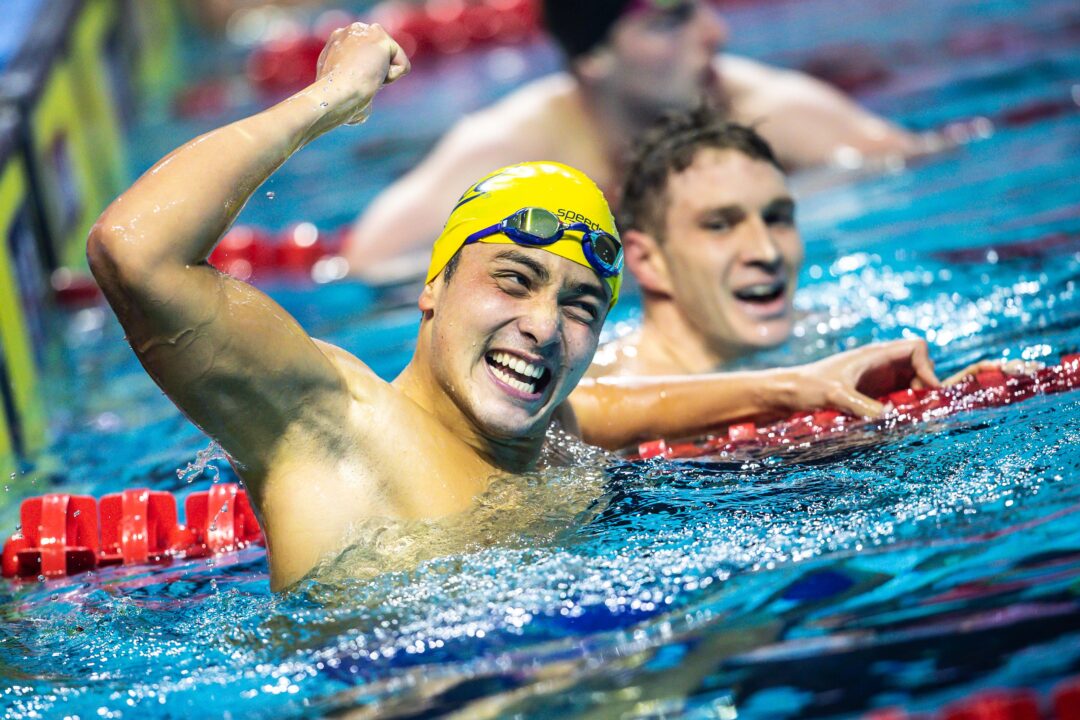
By the way Weinstein drop time at nationals in the 200 free I wouldn’t be surprised if she dropped more time and swam a low 154 (1:53 high maybe you never know), I mean she did beat ledecky and outsplit her the last 50 so if she close who knows
Next stop ….. “The Twilight Zone”
https://youtu.be/XneSsguMvWU
This from the same person ‘I expect Douglass age 21 not swim the 4×100 at 2023 worlds aquatic championships Because the 200 IM semifinals is on the same day as the 400 Free Relay” 🙄
Please, just go back to cloud-cuckoo-land.
Michael Andrew missed making the team not because of the qualifying procedure but because he swam poorly. If Dressel had been anywhere close to his usual form, MA wouldn’t have even won the 50 fly and been in a place to potentially qualify.
Let’s work on changing this MA as victim narrative please.
MA 50 fly 22.8 CD 50 free 22.7
I have conflicting opinions about this…
I’m sorry, but right off the bat, you can’t use “If Dressel was ready…” BS. If I was ready, maybe Dressel would’ve been the odd man out (haha, kidding). You dance with who you brought to prom…meaning if… Read more »
While it’s true that in countries with little depth the 100 and 50 champions are likely going to be the same, the skills really are significantly different, because 50s are mostly-anaerobic races while 100s are universally aerobic (the cutoff being somewhere around 25-30 seconds for oxygen from the lungs to circulate to the muscles in competitively meaningful quantities). Indeed, that’s presumably the entire reason the 50s were added in the first place. If they were just handing out extra medals to winners of the 100s, what would be the point?
And indeed, we can easily come up with any number of swimmers who were stars in 50s but never thrived in 100s. Liam Tancock is sort of my go-to… Read more »
Lindsay Mintenko a 200 freestyler and Caitlin Leveranz a 400 IMer signed off on the selection criteria. They should be interviewed and asked questions about “sprint endurance” and elite sprint training.
“You dance with who you brought to prom”! Awesome! I have to remember that line!
I was absolutely heartbroken for Emma Weyant tbh
In terms of misses of veterans, none of those veterans should necessarily panic.
- Claire Curzan – barely a veteran herself, she was sick and out of the water for over a week just before the meet…and we kept seeing her on the podium…a healthy Claire and I think she cracks a few of those spots.
- Hali Flickinger – this one I felt bad about, because all season at the TYR events she was cooking. Seeing her instagram (which let’s not assume what people post is how they truly feel), she does appear to be just fine. I don’t think her ‘miss’ in the 200 fly means much of anything here. From what we know, she’s been spending more time
… Read more »After the W 200 FL, Hali Flickinger “retired” from the rest of the competition.
Not relay names guy talking more “she’s old and washed up and should retire” BS. Watch her come back and humiliate you like Olivia Smoliga did.
tl;dr- no jk. Good analysis. Not sure about Simone though. Her best days may be behind her. Her legacy will live on forever.
Didn’t show go like 54.5 at a home meet at ASU this year? Probably untapered? Probably just kind of building back into training? I’d never rule her out for one more ‘push’
You know you’ve been spending way too much time reading SwimSwam lately when you can identify YanYan’s writing by reading the first two lines
“Intro written by Braden Keith.”
Obviously was referring to her section
On the women’s side, best bets to return next year:
Bacon, Phoebe
Curzan, Claire
Weyant, Emma
However, it won’t be easy for any of the three aforementioned swimmers.
2019 World Aquatics Championships
Women’s 4 x 100 meter medley relay
World Record
Smith, Regan – 57.57 not 57.47
Hey Yanyan, maybe nitpicking, but did this sentence get edited?
“Erika Brown, Natalie Hinds, and Brooks Curry were both on 4×100 freestyle relays for the last two years, but neither of them made the 100 free ‘A’ final this year.”
There are 3 of them, so the both and neither doesn’t make sense. Could be all and none?
Or maybe it should read “Erika Brown and Natalie Hinds were both on the W4×100 freestyle relays for the last two years, but neither of them made the 100 free ‘A’ final this year. In the men’s event, Brooks Curry found himself in the same position.”